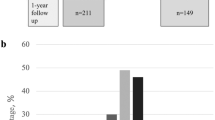Opinion statement
Depression is common in Parkinson’s disease (PD) and associated with considerable morbidity, including a worsening of motor symptoms and measures of quality of life. Therefore, patients with PD should be routinely screened for depressive symptoms with rating scales such as the Geriatric Depression Scale. Patients meeting criteria should be treated using established algorithms for the management of depression and associated symptoms such as insomnia, anxiety, psychosis, and mania. The algorithm outlined in this paper describes the importance of maintaining an adequate dose of medication over a medication trial that can last up to 12 weeks. To optimally monitor patients’ progress, clinicians should also consider using rating scales that measure depression severity, such as the Montgomery-Asberg Depression Rating Scale and Beck Depression Inventory.
Similar content being viewed by others
References and Recommended Reading
Holtzheimer PE, McDonald WM, DeLong MR: Mood disorders in Parkinson’s disease. In The Physician’s Guide to Depression and Bipolar Disorders. Edited by Evans D, Charney DS. New York: McGraw-Hill; 2005:333–354. Provides a more comprehensive review of the epidemiology, etiology, and treatment of dPD.
Leentjens AF, Van den Akker M, Metsemakers JF, et al.: The incidence of Parkinson’s disease in the Netherlands: results from a longitudinal general practice-based registration. Neuroepidemiology 2003, 22:311–312.
Rojo A, Aguilar M, Garolera MT, et al.: Depression in Parkinson’s disease: clinical correlates and outcome. Parkinsonism Relat Disord 2003, 10:23–28.
Kuhn W, Heye N, Muller T, et al.: The motor performance test series in Parkinson’s disease is influenced by depression. J Neural Transm 1996, 103:349–354.
Starkstein SE, Preziosi TJ, Berthier ML, et al.: Depression and cognitive impairment in Parkinson’s disease. Brain 1989, 112:1141–1153.
Kuopio AM, Marttila RJ, Helenius H, et al.: The quality of life in Parkinson’s disease. Mov Disord 2000, 15:216–223.
Caap-Ahlgren M, Dehlin O: Factors of importance to the caregiver burden experienced by family caregivers of Parkinson’s disease patients. Aging Clin Exp Res 2002, 14:371–377.
Weintraub D, Moberg PJ, Duda JE, et al.: Recognition and treatment of depression in Parkinson’s disease. J Geriatr Psychiatry Neurol 2003, 16:178–183.
Marsh L, McDonald WM, Cummings JL, et al.: Provisional diagnostic criteria for depression in Parkinson’s disease: report of an NINDS/NIMH work group. Mov Disord 2006, In press.
McDonald WM, Richard IH, DeLong MR: Prevalence, etiology, and treatment of depression in Parkinson’s disease. Biol Psychiatry 2003, 54:363–375.
Isella V, Melzi P, Grimaldi M, et al.: Clinical, neuropsychological, and morphometric correlates of apathy in Parkinson’s disease. Mov Disord 2002, 17:366–371.
Weintraub D, Oehlberg KA, Katz IR, et al.: Test characteristics of the 15-item Geriatric Depression Scale and Hamilton Depression Rating Scale in Parkinson’s disease. Am J Geriatr Psychiatry 2006, In press.
McDonald WM, Holtzheimer PE, Haber M, et al.: Validity of the 30-item Geriatric Depression Scale in patients with Parkinson’s disease. Mov Disord 2006, In press.
Shulman LM, Taback RL, Rabinstein AA, et al.: Non-recognition of depression and other non-motor symptoms in Parkinson’s disease. Parkinsonism Relat Disord 2002, 8:193–197.
Avila A, Cardona X, Martin-Baranera M, et al.: Does nefazodone improve both depression and Parkinson disease? A pilot randomized trial. J Clin Psychopharmacol 2003, 23:509–513.
Naarding P, Leentjens AF, van Kooten F, et al.: Diseasespecific properties of the Rating Scale for Depression in patients with stroke, Alzheimer’s dementia, and Parkinson’s disease. J Neuropsychiatry Clin Neurosci 2002, 14:329–334.
Leentjens AF, Vreeling FW, Luijckx GJ, et al.: SSRIs in the treatment of depression in Parkinson’s disease. Int J Geriatr Psychiatry 2003, 18:552–554.
MulsantBH, Alexopoulos GS, Reynolds 3rd CF, et al.: Pharmacological treatment of depression in older primary care patients: the PROSPECT algorithm. Int J Geriatr Psychiatry 2001, 16:585–592. Provides a data-based treatment algorithm for depression that is designed for primary care practitioners and other nonpsychiatrists. This algorithm forms the basis for the treatment approach we use for dPD in our clinic.
DeRubeis RJ, Hollon SD, Amsterdam JD, et al.: Cognitive therapy vs medications in the treatment of moderate to severe depression. Arch Gen Psychiatry 2005, 62:409–416.
de MelloMF, de JesusMari J, Bacaltchuk J, et al.: A systematic review of research findings on the efficacy of interpersonal therapy for depressive disorders. Eur Arch Psychiatry Clin Neurosci 2005, 255:75–82.
Keller MB, McCullough JP, Klein DN, et al.: A comparison of nefazodone, the cognitive behavioral-analysis system of psychotherapy, and their combination for the treatment of chronic depression. N Engl J Med 2000, 342:1462–1470.
Bauer M, Forsthoff A, Baethge C, et al.: Lithium augmentation therapy in refractory depression--update 2002. Eur Arch Psychiatry Clin Neurosci 2003, 253:132–139.
UK ECT Review Group: Efficacy and safety of electroconvulsive therapy in depressive disorders: a systematic review and meta-analysis. Lancet 2003, 361:799–808. Provides an excellent, comprehensive review of data on ECT as a treatment for depression.
Kennedy R, Mittal D, O’Jile J: Electroconvulsive therapy in movement disorders: an update. J Neuropsychiatry Clin Neurosci 2003, 15:407–421.
Fregni F, Simon DK, Wu A, et al.: Non-invasive brain stimulation for Parkinson’s disease: a systematic review and meta-analysis of the literature. J Neurol Neurosurg Psychiatry 2005, 76:1614–1623.
Fregni F, Santos CM, Myczkowski ML, et al.: Repetitive transcranial magnetic stimulation is as effective as fluoxetine in the treatment of depression in patients with Parkinson’s disease. J Neurol Neurosurg Psychiatry 2004, 75:1171–1174.
Author information
Authors and Affiliations
Rights and permissions
About this article
Cite this article
McDonald, W.M., Holtzheimer, P.E. & Byrd, E.H. The diagnosis and treatment of depression in parkinson’s disease. Curr Treat Options Neurol 8, 245–255 (2006). https://doi.org/10.1007/s11940-006-0015-9
Issue Date:
DOI: https://doi.org/10.1007/s11940-006-0015-9




